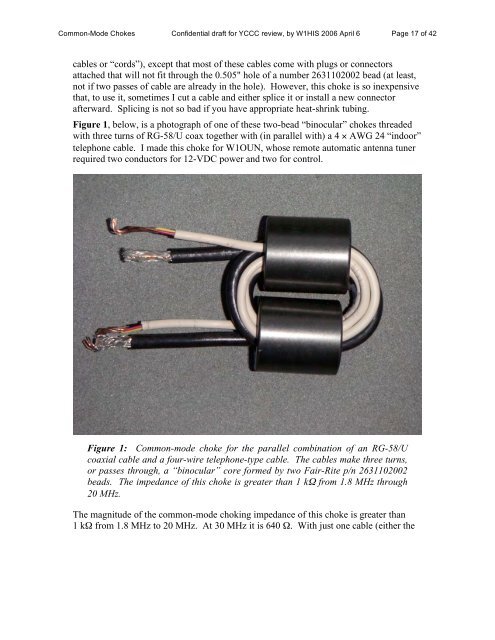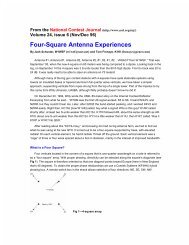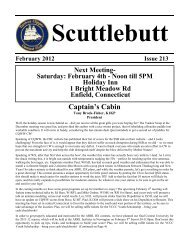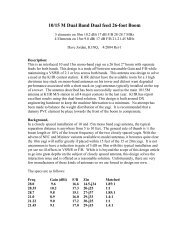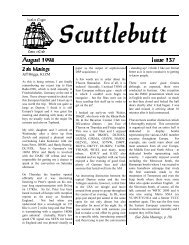<strong>Common</strong>-<strong>Mode</strong> <strong>Chokes</strong> Confidential draft for YCCC review, <strong>by</strong> <strong>W1HIS</strong> 2006 April 6 Page 16 of 42For choking thick cables or thin cables with fat connectors, I use:Fair-Rite p/n 5943003801 (a ring-shaped toroid of mix 43, 2.400" o.d., 1.400" i.d.,0.500" tall / thick), unit price $ 4.58 in the lot of 50 that I bought 3/24/2005.6.2. Thin cable, low to medium RF powerThis section describes a very simple and inexpensive choke made <strong>by</strong> threading a thincable three times through a “binocular” core formed <strong>by</strong> two Fair-Rite p/n 2631102002,mix-31, beads side-<strong>by</strong>-side like the tubes of binoculars.This is a cost-effective choke for any round cable of o.d. 0.2" or less, or “zip cord” of size2 × AWG 16 or less — e.g., small 120- and lower-voltage power cords, telephone cords /cables, computer cables, and coaxial cables for receiving or for transmitting HF power upto 100 W, more or less, depending on cable material and construction. The safe powerlimit is determined <strong>by</strong> a combination of thermal issues and the mechanical stress caused<strong>by</strong> the curvature of the cable in the choke. The radius of this curvature is about 0.5 inch.RG-58/U coax, in which the center conductor is solid copper and the dielectric is solidpolyethylene, is probably safe for 100 W in this choke. RG-58A (Belden 8259) or RG-58C (Belden 8262), in which the center conductor is flexible (stranded, not solid) and thedielectric is also solid (not foamed) polyethylene, is probably safer. In a cable having asolid center conductor, and especially in a cable having foamed dielectric, the centerconductor is more able to mush through the dielectric and short to the shield if the centerconductor is heated <strong>by</strong> too much RF current.Manufacturers of RG-58-type cables typically specify a minimum bending radius of 2.0inches. Subject to this bending limit, and for an ambient temperature of 40°C (104°F),RG-58-type cables are rated to carry about 500 W at 14 MHz with SWR = 1. Unfortunately,I don’t know how any of these cables should be derated for sharper bending. I knowonly that, for a given transmitted power, the power dissipated in the center conductor isproportional to the square root of frequency; and that, for SWR > 1, the power dissipatedat a maximum of the standing wave in the transmission-line-mode current is magnified<strong>by</strong> a factor of the square root of the SWR. Thus, for example, at 28 MHz with SWR = 4,the transmitted-power limit for RG-58-type cable is reduced to 175 W — before anyallowance for bending-radius < 2.0 inches. So be careful. Don’t use this common-modechoke (or any device) in a transmitting feedline where it could start a fire <strong>by</strong> shorting andarcing. Remember that polyethylene, and many cable jacket materials, are flammable.For higher transmitted power, some hams have suggested using RG-303 (Belden 84303)coax in this choke. RG-303 has PTFE dielectric, which remains solid (although soft) upto a significantly higher temperature than polyethylene does. RG-303 also has a largercenter-conductor than RG-58A or C has (AWG 18 vs. 20). This center conductor is solid,not stranded. However, as previously mentioned, W1JR has wound RG-303 on ferriterings having 0.5" square cross-sections (so the inside radius of curvature of the coaxwould be 0.35"), and (AFAIK) he has not reported a failure at legal-limit power.The choke described in this section would be my first choice for all kinds of smalldiametercable (including telephone cables or “cords”; serial-data, USB, FireWire,10Base-T Ethernet and other computer cables; and low-voltage or 120-VAC power
<strong>Common</strong>-<strong>Mode</strong> <strong>Chokes</strong> Confidential draft for YCCC review, <strong>by</strong> <strong>W1HIS</strong> 2006 April 6 Page 17 of 42cables or “cords”), except that most of these cables come with plugs or connectorsattached that will not fit through the 0.505" hole of a number 2631102002 bead (at least,not if two passes of cable are already in the hole). However, this choke is so inexpensivethat, to use it, sometimes I cut a cable and either splice it or install a new connectorafterward. Splicing is not so bad if you have appropriate heat-shrink tubing.Figure 1, below, is a photograph of one of these two-bead “binocular” chokes threadedwith three turns of RG-58/U coax together with (in parallel with) a 4 × AWG 24 “indoor”telephone cable. I made this choke for W1OUN, whose remote automatic antenna tunerrequired two conductors for 12-VDC power and two for control.Figure 1: <strong>Common</strong>-mode choke for the parallel combination of an RG-58/Ucoaxial cable and a four-wire telephone-type cable. The cables make three turns,or passes through, a “binocular” core formed <strong>by</strong> two Fair-Rite p/n 2631102002beads. The impedance of this choke is greater than 1 kΩ from 1.8 MHz through20 MHz.The magnitude of the common-mode choking impedance of this choke is greater than1 kΩ from 1.8 MHz to 20 MHz. At 30 MHz it is 640 Ω. With just one cable (either the


